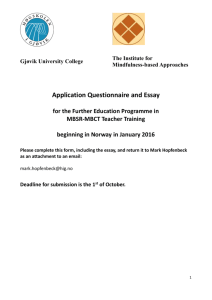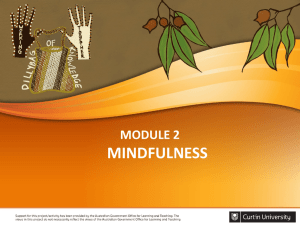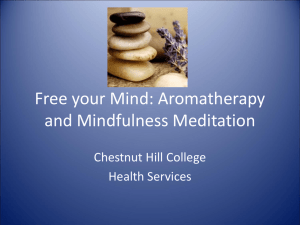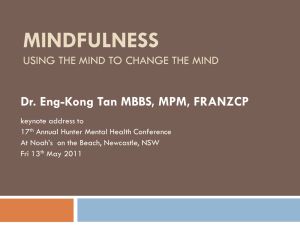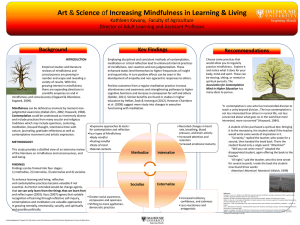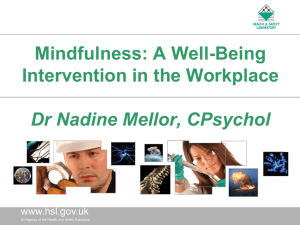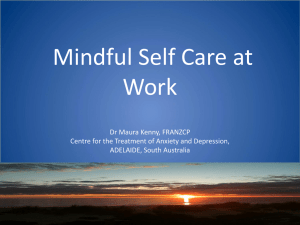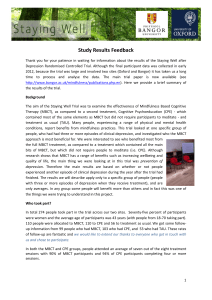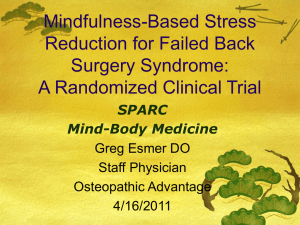Introduction to Mindfulness Sarah Silverton
advertisement
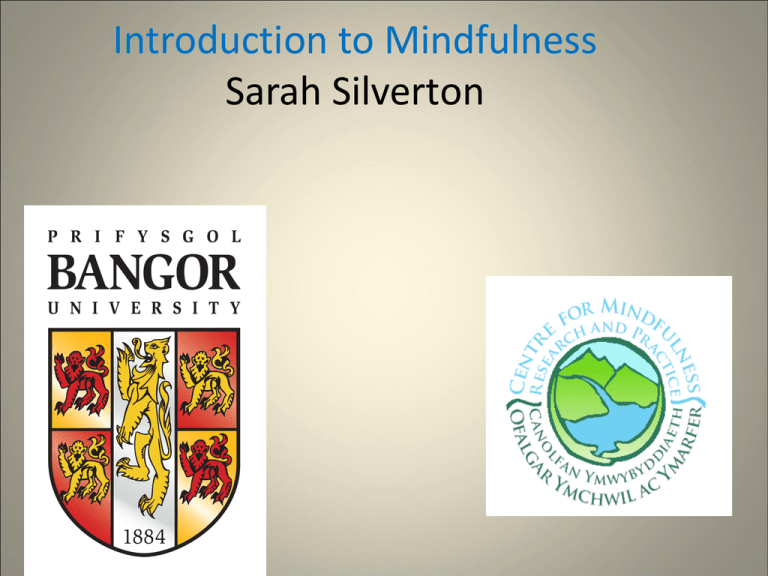
Introduction to Mindfulness Sarah Silverton Mindfulness Mindfulness is.... ”....paying attention on purpose, in the present moment, non-judgementally....” Jon Kabat Zinn Mindfulness meditation is NOT: • Positive thinking • A relaxation technique • Going into a trance • Trying to blank your mind Background to Mindfulness Courses Mindfulness has its origins in Eastern, Buddhist philosophy. It was adapted to a secular, 8 week programme format Mindfulness Based Stress Reduction(MBSR) in the USA by Jon KabatZinn in 1979. It was initially offered in a hospital setting for people with a variety of health conditions. Coming to our Senses! Learning through meditation practice to approach our experience in new ways Moment by moment non-judgmental awareness of body sensations, thoughts and emotions • Formal meditation practice - bodyscan, mindful movement, sitting practice • Informal practice - awareness of present moment experience during daily life Breathing and Body Practice Being here in this moment. Focus of Attention Like a torch beam? • Has a limited capacity • Can be “caught” • Can be directed • Capacity for a broad or narrow focus Environmental Input Two Modes of Self-focus: Conceptual and Experiential Conceptual Experiential / Direct Noticing Seeing Tasting Hearing Smelling Visceral sensations Proprioceptive sensing Touching Labeling Elaborating Analyzing Judging Goal-setting Planning Comparing Remembering Self-reflecting Becoming Aware of our Mind’s Activity. As we practice mindfulness it becomes apparent that the mind will “have its say” in all that we do. The mind thinks just as the heart beats! We will notice: Judgements = liking or disliking Associations = memories, stories, comparisons Emotional inter-relationship with thoughts Thoughts don’t occur singularly or without some emotional “flavour”. Commentary = our thoughts comment on all our experiences. Dealing with Stresses in our Lives • When we perceive a threat we tend to react automatically using one of two ancient doing mind strategies: • Adrenalin based reactions – saving ourselves from danger by fighting with, running away from, protecting or camouflaging ourselves... ....fight, flight and freeze. • Problem-solving processes where we attempt to fix or resolve the perceived problem Problem Solving Discrepancy Monitoring : mind the gap thinking. Perceived gap between how things are and how they should be. Focus is on closing the gap and will remain forefront of our awareness until the gap is closed. Appropriate for some tasks and problems we encounter. The mind becomes very active trying to resolve emotional problems through thinking. This ruminative thinking often increases the problem. Let’s try this..... But also...... ...........a third way Approaching our experience and responding mindfully Mindfulness: Being With and Approaching our Experience • Seeing things as they actually are, here and now/in this moment • Bringing a friendly curiosity to our experience, however that is • Investigating the detail of our experience • Non-fixing, not trying to change what’s here. • Choices to respond based on full and current information - rather than habitual reacting. • Opening to a broader view including what is “right” as well as perceived problems. Managing Stress Mindfully Responding wisely and appropriately rather than adding to the difficulty, as it is perceived, through habitual reactions. Taking a Breathing Space Refreshments What do you notice as you have this break? Movement Practice Early research into MBSR Chronic pain (See Kabat-Zinn, Lipworth & Burney, 1985, The clinical use of mindfulness meditation for the self-regulation of chronic pain, J. of Behavioural Medicine, 8, 163-190; Kabat-Zinn, Lipworth, Burney & Sellers, 1987, Four-year follow up of a meditation program for the self-regulation of chronic pain: Treatment outcomes and compliance, Clinical J. of Pain, 2, 159-173) Anxiety (See Kabat-Zinn, Massion, Kristeller et al., 1992, Effectiveness of a meditationbased stress reduction program in the treatment of anxiety disorders, American J. of Psychiatry, 149, 936-943) Psoriasis (See Kabat-Zinn, Wheeler, Light et al., 1998, Influence of a mindfulness meditationbased stress reduction program on rates of skin clearing in patients with moderate to severe psoriasis undergoing phototherapy… Psychosomatic Medicine, 50, 625632) Recent research into MBSR Mindfulness research now mainstream in USA e.g.: – MBSR for cancer patients (Carlson & Speca), for medical students (Shapiro) etc. – Neuroscience research on mindfulness meditation (Davidson) – Tools to measure mindfulness have been developed Research into Mindfulness Based Cognitive Therapy • Williams, Teasdale, Segal (2000) MBCT was adapted MBSR for a specific population of depressed patients, incorporating some CBT. A multi-site randomised control trial explored the effectiveness of Mindfulness Based Cognitive Therapy (MBCT) for people with a history of depressive illness. Found that MBCT reduced the likelihood of depressive relapse by half for those with 3 or more episodes of depression. • Teasdale and Ma (2004)- replicated findings of previous trial. • MBCT has NICE guidelines approval and is now the recommended treatment for recurrent depressive illness (ahead of anti-depressant medication). Further research on MBCT • Kuyken et al (2008) - comparing MBCT to continuation antidepressant medication • Suicidal depression (Williams et al 2006) • Cancer patients (Ingram (2005) • Treatment resistant depression (Kenny and Williams 2007) • Bipolar disorder (Williams et al 2007) • Residual depression (Kingston et al, 2007) • Chronic fatigue Surawy and Roberts (2005) Mindfulness Practice Is a Radically Different Approach to Living Our Lives and Managing Stress... •Increasing awareness - We co me to realise that we are usually operating on “automatic pilot “ - our tendency for our minds to be more frequently in the past or in the future rather than with our experience in this moment. •Placing our attention where we want it to be (concentration meditation) and... •Developing a new relationship with our experience (mindfulness meditation). •Being Mind rather than Doing Mind - making space for and turning towards rather than resisting or working to change experiences we don’t like. (Discrepancy-based processing.) •Responding to experience based on awareness of what’s actually here rather than habitually reacting Thank you!
